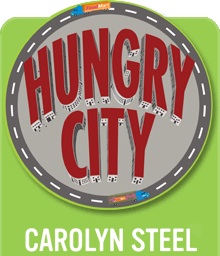
How on earth do we get 24 million meals into and out of a city like London every single day? That, essentially, is the question that Hungry City tries to answer. It’s a book about cities and how we feed them, in which Steel casts an Architects analytical eye over modern and historical food systems. She finds a modern system that hasn’t learnt from the mistakes of the past, is essentially sick, and in need of major by-pass surgery.
Working systematically through the histories of how we farm the land, get food to cities, how it is sold, prepared, eaten, and disposed of, Steel paints a gloomy picture with few green shoots of hope; from the bloody furtherance of the Empire to find grain for Rome, to modern ‘eco’ developments with Tesco the only choice for grocery shopping (as they funded it anyway).
One glimmer of hope comes about halfway through when Steel describes the role of the modern cook:
“Cooking is about much more than chopping up a few vegetables and throwing them in a pan, or putting a readymade pizza in the microwave. Because cooks control not only what goes out of a kitchen, but what comes into it, they are a vital link in the food chain – the guardians of our gastronomic know-how. Only cooks know how to source raw food, tell its quality, make it taste delicious, manage and store it, make use of leftovers. Few skills have a greater collective impact on our quality of life. People who don’t cook don’t use local food shops, invite their friends around for dinner, know where their food comes from, realise what they’re putting into their bodies, understand the impact of their diet on the planet – or educate their children in any of the above.”
As cooks we have an enormous amount of power, perhaps that’s why the food industry has been trying to take the cooking out of cooking for the last 50 years! We could revolutionise the UK’s food system in a shot if enough of us took up our wooden spoons. After all, demand drives supply.
Despite painting a depressing picture, Steel finishes on a flourish, with some humbly presented ‘small answers’. Sitopia, she describes, is utopia grounded in reality, where cities are build with food at the centre – eligible ground is used to grow food, markets and local food shops thrive, food is celebrated, local producers are linked up with the city through a lattice-like food network, food from further afield is ethically sourced, new developments are built around food networks, schools actually teach kids about food, and new houses are built with large kitchens at the centre of the home.
Is Sitopia possible? Who knows, Steel acknowledges that in it’s purest form it is a Utopian vision, but any little move in that direction is a positive move. It’s certainly hard to see in well-established cities like Birmingham where our food systems are already set in a (cacophonous) rhythm . But there’s always chinks of light, and some of the great things we’re discovering, and planning on doing ourselves, are hopefully bringing us baby-steps closer to a Sitopian Birmingham. You can buy the book here, it’s a must read for anyone who cares what’s on their plate.